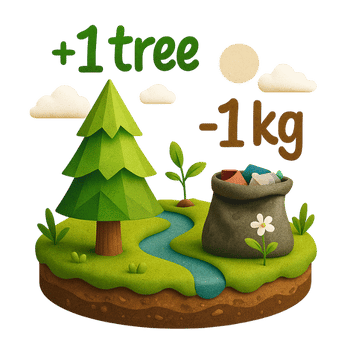Global nature is in freefall. The WWF’s Living Planet Report 2024 sounded the alarm: average wildlife populations have plunged 73% since 1970. Scientists call this decline the “fastest rate in human history,” threatening the ecosystems we all depend on. In fact, habitat loss and other pressures put up to a million species at risk of extinction. What does this mean for you? Every species lost chips away at clean water, stable food supplies, and natural protections that you normally take for granted. In short, a looming “biodiversity collapse by 2030” could soon hit home, with higher grocery bills, battered coasts, and more unpredictable weather in our daily lives.
Bleaching Reefs and Lost Livelihoods
Coral reefs underpin a $36 billion global tourism industry and support one billion people. They also house a third of all ocean species and buffer coastlines from storms. But warming seas are crushing them. In early 2025 scientists reported the fourth mass bleaching event on record, with 84% of the world’s reefs suffering lethal heat stress since 2023. In practical terms, this translates to lost vacations and paychecks for communities that rely on reefs. For example, Australia’s Great Barrier Reef – a $6.4 billion/year tourism magnet – saw tourist visits plunge 10–20% after major bleaching, costing the economy over $1 billion. When coral cover dies back, fish stocks crash and coastal resorts lose revenue. (Coral reefs alone provide as much as $10 trillion in ecosystem services globally, from fish to storm protection – services we’d sorely miss.)

Pollinators and Plummeting Harvests
Farming itself is under siege. Bees, butterflies, bats and other pollinators are disappearing. A recent North American study found over 22% of native pollinators are now at high risk of extinction. These tiny creatures contribute an estimated $15 billion a year to U.S. agriculture by pollinating fruits, nuts and vegetables. As pollinator populations fall, yields of everyday foods – apples, almonds, berries, coffee and more – start to drop. This drives up your food costs and cuts the variety on supermarket shelves. In fact, U.S. experts warn that honeybee losses could reach 70% by the end of the year 2025, jeopardizing pollination of crops from almonds to blueberries. Losing one-fifth of pollinators means fewer crops per acre, prompting shortages and higher prices at the grocery store – a very tangible outcome of biodiversity loss in your kitchen.
Fires, Floods and Food Shocks
Extreme weather in 2025 has underscored these links. A string of January 2025 wildfires in Southern California exploded under record drought and winds, killing ~30 people and forcing over 200,000 to flee. In the same year, unprecedented rains in the Amazon basin triggered catastrophic flooding – for example, aerial surveys over Yarinacocha, Peru (below) show rivers bursting their banks and inundating farms. In late June 2025, heavy rains in Colombia and Venezuela caused deadly floods and landslides, with dozens of lives lost. These disasters are partly climate-driven and are amplified by degraded ecosystems (cut forests and stripped wetlands can no longer absorb floodwaters). The result: damaged crops, shuttered roads and spiking food prices. Already in 2025 we’ve seen shortages and price jumps on shelves as heatwaves, droughts and floods slash harvests. In short, nature’s collapse is feeding into the climate chaos around us, making everyday weather more dangerous and expensive.

Policy in Action: A Race to 2030
The world has begun to respond. In late 2024 and early 2025 the UN’s COP16 Biodiversity Summit (first in Cali, Colombia and resumed in Rome) delivered important commitments. Nations agreed on a strategy to mobilize $200 billion per year by 2030 for nature and finalized rules to track progress on the global biodiversity framework. A landmark “Cali Fund” was launched to share biotech and data benefits, and indigenous peoples’ roles were elevated in conservation plans. At home, countries are also moving. For example, Canada unveiled a 2030 Nature Strategy and a new Nature Accountability Bill, legally committing the government to its biodiversity targets. In Europe, the world’s first Nature Restoration Regulation took effect in 2024, mandating that 20% of land and sea be actively restored by 2030. These policy steps – part of the “2030 mission” to halt biodiversity loss – aim to slow the collapse.
The Toll on You: Why This Matters Today
- Food and Prices: One-fifth of pollinator species are near extinction, threatening crops you eat. Fruits, nuts and vegetables rely on bees and butterflies; fewer pollinators mean smaller harvests and higher grocery bills.
- Coastal Tourism and Jobs: Reef and beach losses translate to real dollars. Bleached corals have already cut tourism income – e.g. Australia lost ~$1B in reef tourism after bleaching. Many coastal communities will feel this in lost wages and business.
- Storms and Disaster Costs: Healthy forests, wetlands and reefs act as natural flood barriers. Their loss exposes hundreds of millions more people to flooding and hurricanes. In practical terms, this means bigger storms hitting communities, with higher insurance and recovery bills.
- Daily Services: Nature cleans our water and air, so its decline can raise your health costs. Even one study estimates that degrading nature already puts half of global GDP (~$44 trillion) at risk. When forests and soils are ruined, you might pay more to filter water or deal with air pollution.
Biodiversity collapse is not a distant problem – it’s unfolding now, right where you live. The actions we take this year and next will decide whether we can avert a full-blown crash by 2030. Restoring reefs, protecting pollinators, passing strong nature laws – these are not just environmental ideals, but immediate steps to protect our jobs, our health and our children’s future.
Sources: Major findings and figures are from the WWF Living Planet Report 2024, scientific studies and news (e.g. Nature Conservancy, ICRI, NatureServe) as cited above. The economic and policy data reflect the latest reports through 2025.



